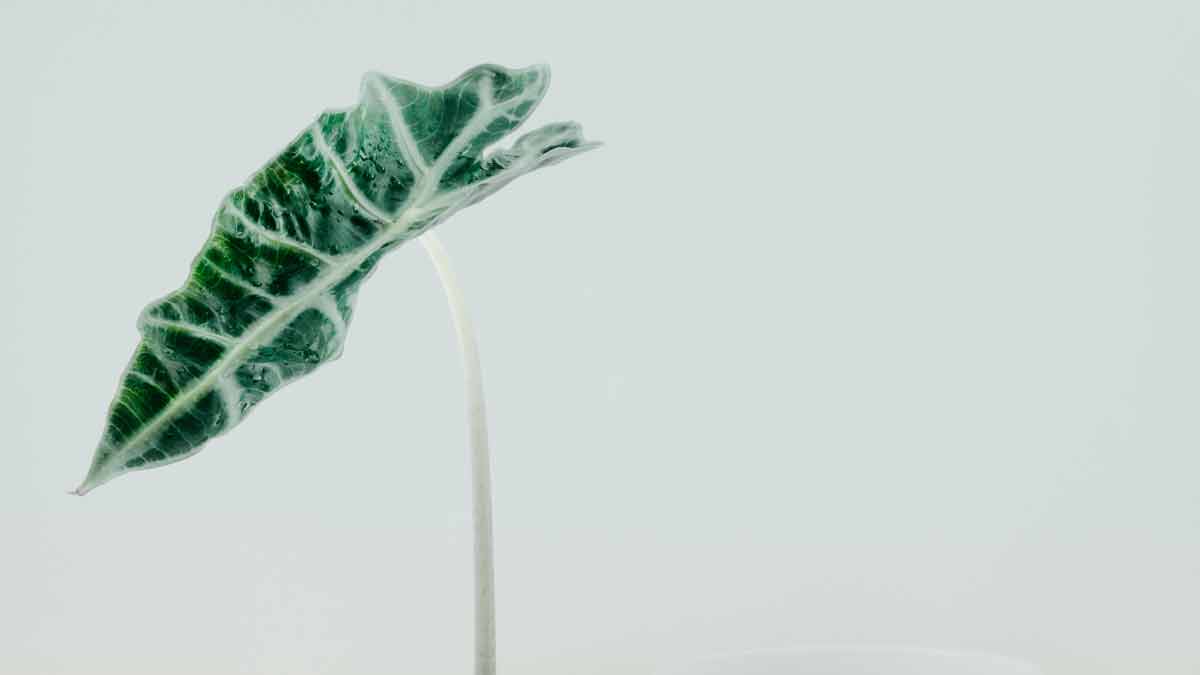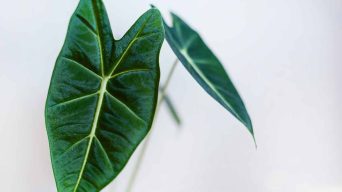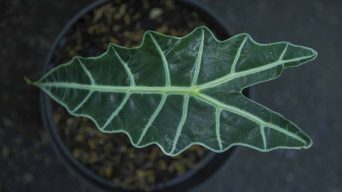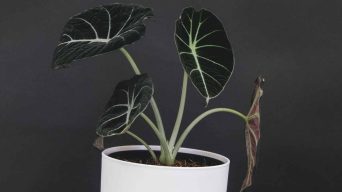An underwatered Alocasia has dry, crispy leaves and receding soil. To prevent this, keep it well-watered, especially during warmer months. Cut back on watering during winter when it’s cooler. Alocasia prefers consistently moist soil and may die if kept too dry or too wet. Drooping leaves can indicate underwatering.
Alocasia plants, known for their stunning and striking foliage, require proper care to thrive in your home or garden.
One common problem many Alocasia owners face is underwatering, which can lead to various issues.
Here we’ll explore the causes of underwatered Alocasias, how to recognize the symptoms early on and provide practical solutions to ensure your plant regains health and vitality.
Causes Of Underwatered Alocasia Plants
Inadequate watering, poor soil drainage, excessive sun exposure, and poor water quality are leading causes of underwatered Alocasia plants.
These factors can harm the health and appearance of these tropical plants.
Identifying and addressing the root cause of underwatering is crucial in ensuring the longevity and vibrancy of these unique and beloved botanical specimens.
Inadequate Watering
Inadequate watering is a common issue faced by Alocasia owners, resulting in underwatered plants that struggle to thrive.
As an Alocasia owner, it’s crucial to understand the specific water requirements of your plant, as these tropical beauties need consistent moisture in their soil to grow and remain healthy.
To ensure proper hydration, create a balanced watering schedule tailored to your Alocasia plant’s needs, considering factors like humidity levels and temperature within its environment.
For instance, you may water more frequently during warmer growing seasons with high humidity levels than during colder months with low humidity.
Additionally, use techniques such as bottom-watering or a well-draining potting mix rich in nutrients like perlite or coconut coir for optimal results.
Poor Soil Drainage
Poor soil drainage can be detrimental to the health of your Alocasia plant, as it prevents the roots from accessing sufficient oxygen and increases the risk of root rot.
This issue is often caused by overly compact soil or inadequate potting mixtures that lack proper aeration components, such as perlite or bark chips.
To improve soil drainage for your beloved tropical plant, ensure you use a well-draining potting mixture that contains materials like perlite or coarse sand, which promotes optimal airflow around the roots.
Additionally, select pots with adequate drainage holes to prevent excess water accumulation at the bottom.
Excessive Sun Exposure
Excessive sun exposure is a common issue that Alocasia owners face, as these tropical plants prefer indirect sunlight to thrive. Direct sunlight can cause the leaves to become yellow and dry, ultimately hindering the growth and health of your beloved plant.
To counteract this problem and restore the natural beauty of your Alocasia plant, consider moving it away from windows with prolonged direct sunlight or filtering the light using sheer curtains.
Doing so will provide bright indirect light without subjecting your indoor plant to harmful rays that can cause leaf discoloration and damage.
Poor Water Quality
Poor water quality is one of the main causes of underwatered Alocasia plants.
When the plant is regularly exposed to low-quality water, it can absorb harmful chemicals and minerals that prevent the proper absorption of essential nutrients.
Additionally, water impurities can hinder soil drainage, leading to root rot and inadequate hydration.
A helpful tip for Alocasia owners is to ensure they use high-quality water or even consider using distilled or filtered water when watering their plants.
Symptoms Of Underwatered Alocasia Plants
Alocasia plants are a beautiful addition to any indoor or outdoor space, but like any living organism, they require proper care and attention to thrive.
One of the most common issues that Alocasia plant owners face is under-watering, which can lead to various symptoms that can negatively impact the plant’s health and appearance.
Below, we will explore the signs of underwatered Alocasia plants, including yellowing leaves, wilting, stunted growth, and brown leaf tips, and how to remedy these issues to ensure your Alocasia plant remains healthy and vibrant.
Yellowing Leaves
Yellowing leaves in Alocasia plants can be a common issue and are often caused by overwatering or insufficient light.
The roots may become waterlogged when the plant is overwatered, leading to root rot and yellowing leaves.
Other factors contributing to yellowing leaves include poor soil drainage, low humidity levels, poor water quality, or pest infestations.
It’s essential to address this issue promptly to prevent any further damage or potential loss of your Alocasia plant.
You can adjust your watering schedule accordingly and ensure that your plant receives adequate sunlight while watching for pests such as fungus gnats that commonly affect indoor plants.
Wilting Or Drooping
One of the most common symptoms of an underwatered Alocasia plant is wilting or drooping leaves.
This occurs because the plant does not have enough water to support its growth and nourishment.
Leaves may appear limp, soft, or wilted when touched, losing their firmness and vibrant color.
However, it is essential to note that overwatering can also cause similar symptoms in Alocasia plants.
When exposed to too much moisture for prolonged periods, roots can become saturated with water and ultimately suffocate from a lack of oxygen.
As a result, leaves may wilt or droop due to excessive water intake rather than inadequate watering practices.
Stunted Growth
One of the most common symptoms of underwatered Alocasia plants is stunted growth.
This can be frustrating for plant owners who want to see their Alocasia thrive and reach their full potential.
Stunted growth in Alocasia plants can occur when they don’t receive enough water, which restricts their ability to absorb essential nutrients from the soil.
Regular watering ensures the soil stays consistently moist but not overly saturated.
Additionally, sufficient sunlight exposure and optimal humidity levels will promote healthy growth in your Alocasia plant.
Brown Leaf Tips
Brown leaf tips are a common symptom of underwatering in Alocasia plants.
This occurs when the plant is not receiving enough water, causing the tips of the Alocasia leaves to turn brown and dry out.
If left untreated, this can spread throughout the entire leaf and cause further damage.
To fix brown leaf tips caused by underwatering, increasing the watering frequency and ensuring that your Alocasia is getting enough water is recommended.
Proper drainage is also essential for preventing overwatering or root rot, which can lead to similar symptoms.
Keep an eye on your plant’s health and adjust care accordingly if necessary.
Helping An Underwatered Alocasia
If you’ve noticed your Alocasia plant looking a little droopy or its leaves turning yellow, it could be a sign of dehydration.
But don’t worry; you can help your beloved plant recover with simple watering techniques.
Here we’ll share tips on properly watering an underwatered Alocasia to bring it back to its vibrant, healthy self.
Following a consistent watering schedule and ensuring the soil is appropriately moist can help your plant thrive and prevent future dehydration.
Proper Watering Techniques
Proper watering is vital to keep your Alocasia plants healthy and thriving.
Here are some essential tips on how to water an underwatered Alocasia plant:
- Watering frequency: Unlike many other houseplants, Alocasia plants prefer to be kept moderately moist at all times. However, watering too frequently can lead to overwatering, which can cause root rot. To avoid this, water your plant only when the top 2-3 inches of soil have dried out.
- Water quality: Use high-quality water free from chemicals and minerals that can harm the plant’s roots. If you live in an area with hard water, consider using filtered water or rainwater instead.
- Watering technique: When watering your Alocasia plant, drench the soil thoroughly until water flows out of the pot’s drainage holes. This helps ensure that the entire root system gets hydrated properly.
- Drainage: Good drainage prevents excess moisture and allows the roots to thrive. Ensure your pot has adequate drainage holes at the bottom so that any excess water can drain freely.
- Humidity: Alocasia plants thrive in a humid environment; however, excessive humidity can lead to fungal growth and other problems. Maintain a moderate humidity level by misting the leaves regularly or using a humidifier.
Improving Soil Drainage
Improving the soil drainage of your underwatered Alocasia is crucial for saving the plant.
Here’s how to do it:
- Use a well-draining soil mix: Alocasias prefer a soil mix that drains quickly and doesn’t retain water for too long. You can mix by combining potting soil, perlite, and sand in equal parts.
- Add pebbles or gravel to the pot: Placing a layer of pebbles or gravel at the bottom of the pot can help improve drainage by allowing excess water to escape through drainage holes.
- Repot in a larger container: If your Alocasia has outgrown its current pot, repotting it into a larger container with fresh well-draining soil can help improve soil drainage.
- Check the drainage holes: Make sure that the drainage holes aren’t clogged with soil or debris, as this can impede water from draining out of the pot.
- Elevate the plant: Placing your Alocasia on top of a stand or pedestal can improve air circulation around the plant and help prevent water from collecting at the bottom of the pot.
Reducing Sun Exposure
Alocasia plants thrive in bright, indirect sunlight, but too much direct light can cause them to wilt and turn yellow.
If your Alocasia is underwatered, it may be especially susceptible to the negative effects of excess sun exposure.
Remember that every Alocasia is different, so pay close attention to how your plant responds to changes in lighting conditions.
If you notice improvement after reducing sun exposure but feel the plant still looks unhealthy, consider checking for other potential issues like poor soil drainage or pest infestation.
Increasing Humidity Levels
Increasing humidity levels is a crucial factor in reviving an underwatered Alocasia plant.
These tropical plants require high humidity to thrive; low levels can cause their leaves to droop or dry out.
To increase humidity, you can mist the plant regularly with clean water or place it near a humidifier.
Another effective approach is to group your Alocasia with other indoor plants as they release moisture into the air through transpiration.
One fantastic way to maintain proper moisture levels while preventing pests and diseases is by misting with a Neem oil solution.
This natural treatment deters common houseplant pests like spider mites, mealybugs, and scale insects from feeding on your prized Alocasia leaves.
It also provides an added layer of protection against fungal growth caused by excess moisture in the soil that often leads to root rot.
Repotting The Plant
Repotting an underwatered Alocasia can be a game-changer in its recovery.
When the plant’s roots are compact and too tightly packed together, nutrients and water cannot reach all parts of the soil evenly.
Repotting to a larger container with fresh soil allows the roots to expand and get adequate air circulation, leading to better absorption of nutrients and water.
Repotting should be done during the growing season when the plant has started producing new leaves.
Before repotting your Alocasia, ensure it is not overwatered or suffering from root rot; otherwise, it may not survive after transplanting.
Afterward, monitor your plant closely for signs of improvement, like new growth or healthier-looking leaves.
In conclusion, quick action like repotting can save an underwatered Alocasia in dire situations, as dehydration leads to slower growth rates or, even worse – death!
If you notice yellowing leaves or wilting on your houseplant despite watering consistently (and correctly), consider looking into other possible causes, such as poor drainage or pest infestation, before attempting any measures.
Checking For Pests
Pests are a common problem in Alocasia plants, and checking for them is crucial in helping your underwatered Alocasia thrive.
Some pests to look for include spider mites, scale insects, and mealybugs.
If left unchecked, these pesky critters can cause leaf discoloration, deformation, and even death.
To check for pests, inspect the leaves and stems of your plant regularly.
Look for any signs of discoloration or small moving dots on the surface of the leaves.
You may also notice webbing or sticky residue on the plant’s surface if it has been infected with spider mites or scale insects, respectively.
If you do find evidence of pests on your plant, take immediate action to remove them using natural sprays or insecticides explicitly designed for houseplants.
Tips To Prevent Underwatering Alocasia Plants
Caring for Alocasia plants can be a rewarding experience, but it requires careful attention to their unique needs.
Underwatering is a common issue that can lead to drooping leaves and stunted growth.
Fortunately, you can take several simple steps to ensure your Alocasia thrives.
From establishing a watering schedule to monitoring soil drainage and sunlight exposure, these tips will help you create a healthy environment for your tropical beauty to flourish.
Read on to discover how to prevent underwatering and keep your Alocasia vibrant and lush.
Establishing A Watering Schedule
Establishing a consistent watering schedule is crucial for maintaining the health of your Alocasia plant. Here are some tips to help you select a watering routine:
- Determine the soil moisture: Before watering, check the soil moisture by sticking your finger about an inch into the soil. If it feels dry, it’s time to water.
- Observe your Alocasia’s behavior: Watch your Alocasia plant closely and note how quickly its soil dries out. This will help you determine how frequently you need to water.
- Consider environmental factors: Watering frequency depends on temperature, humidity, and air circulation. Plants generally require less water in cooler temperatures and higher humidity levels.
- Water thoroughly: When it’s time to water, be sure to give your Alocasia plant a thorough soaking until water begins pooling in the planter’s saucer or drainage hole.
- Use high-quality water: It’s essential to use high-quality water free from contaminants like chemicals or minerals that can harm your plant.
Ensuring Proper Soil Drainage
Proper soil drainage is crucial for preventing underwatering of Alocasia plants.
When soil does not drain properly, the roots can become waterlogged and rot, leading to stunted growth and yellowing leaves.
To ensure proper soil drainage, choosing a well-draining potting mix that allows excess water to escape easily is essential.
Another critical step is to make sure there are adequate drainage holes in the bottom of the pot.
Without these holes, excess water has nowhere to go and can accumulate in the bottom of the pot, causing soggy soil and root rot.
Overall, taking steps to improve soil drainage will help prevent underwatering issues with your Alocasia plant, ensuring healthy growth and vibrant foliage all year round.
Providing The Right Amount Of Sunlight
Alocasia plants require a good amount of sunlight to thrive, but providing them with the appropriate amount is crucial.
Direct sunlight can cause scorching to their leaves that could lead to irreversible damage.
Bright, indirect light for 6-8 hours a day is recommended for Alocasia plants.
Additionally, ensure that no obstacles obstruct the light from reaching the plant.
On the other hand, if your Alocasia is exposed to too much direct sun, its leaves may turn yellow and brown due to dehydration and heat stress.
Using High-quality Water
Using high-quality water is essential for maintaining a healthy Alocasia plant.
When watering your Alocasia, make sure you are using clean and chlorine-free water.
Chlorine can damage the root system, causing the leaves to turn yellow and curl up.
To ensure that you provide high-quality water for your Alocasia plant, consider setting up a rainwater collection system or using filtered or distilled water as an alternative option.
These methods will help eliminate harmful chemicals in tap water and provide optimal growing conditions for your tropical beauty.
Consistently Monitoring The Plant’s Health
Regularly monitoring the health of your Alocasia plant is essential to prevent underwatering.
One of the easiest ways to do this is by observing its leaves.
Yellowing, wilted, or drooping leaves are common signs that your plant needs more water.
Aside from checking the leaves, you should also monitor the soil moisture level and environmental conditions like humidity and sunlight exposure.
You can help ensure your Alocasia stays healthy and thriving for years by consistently monitoring these factors and making necessary adjustments.
Final Thoughts
Underwatering can quickly lead to the demise of your beloved Alocasia plants.
Recognizing the symptoms of underwatering and taking action promptly is essential for ensuring their health and longevity.
You can keep your Alocasia thriving even in less-than-ideal environments by providing proper watering techniques, ideal soil drainage conditions, reducing sun exposure, increasing humidity levels, and checking for pests regularly.
Remember that prevention is always better than cure; establish a regular watering schedule and monitor your plant’s health to prevent future problems before they occur.







